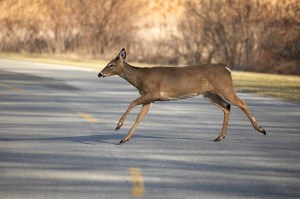

 Cars and deer can be a lethal combination. An increase in urban sprawl and more roads being built through wildlife habitats have displaced deer from their natural habitat, leading to a rise in deer-vehicle collisions, according to the Insurance Information Institute (I.I.I)
Cars and deer can be a lethal combination. An increase in urban sprawl and more roads being built through wildlife habitats have displaced deer from their natural habitat, leading to a rise in deer-vehicle collisions, according to the Insurance Information Institute (I.I.I)
Deer migration and mating season generally runs from October through December, and causes a dramatic increase in the movement of the deer population. As a result, more deer-vehicle collisions occur in this period than at any other time of year, so drivers need to be especially vigilant.
An estimated 1.23 million deer-vehicle collisions occurred in the U.S. between July 1, 2011 and June 30, 2012, costing more than $4 billion in vehicle damage, according to State Farm, the nation’s leading auto insurer.
Damage caused by an accident with deer or other animals is covered under the optional comprehensive portion (not the collision portion) of an automobile insurance policy. Comprehensive auto insurance includes coverage for: fire, theft, vandalism or malicious damage, riot, flood, earthquake or explosion, hail, windstorm, falling or flying objects, damage due to contact with a bird or animal and sometimes, depending on the policy, windshield damage.
The average claim for deer-vehicle collisions between July 1, 2011 and June 30, 2012 was $3,305, up 4.4 percent from the previous year with costs varying depending on the type of vehicle and severity of the damage. Over the last four years, the number of deer-related claims paid out by State Farm increased 7.9 percent, while other claims involving moving vehicles (i.e. first-party, physical damage claims not caused by weather, criminal activity or fire) declined 8.6 percent.
The Insurance Institute for Highway Safety (IIHS) noted that deer-vehicle collisions in the U.S. cause about 200 fatalities annually.
“Drivers should stay alert and pay particular attention to the sides of the road, especially during the hours just before dusk and just before daylight,” said Loretta Worters, vice president of the I.I.I. “Fortunately, there are steps you can take to decrease the likelihood of being involved in a deer-vehicle collision.”
Always wear your seatbelt. The IIHS reports that in a study of fatal animal crashes, 60 percent of people killed were not wearing a seatbelt. Sixty-five percent of people killed in animal related crashes while riding motorcycles were not wearing a helmet.
Be especially attentive from sunset to midnight and during the hours shortly before or after sunrise. These are the highest risk times for deer-vehicle collisions.
Brake firmly when you notice a deer in or near your path, but stay in your lane. Many serious crashes occur when drivers swerve to avoid a deer and hit another vehicle or lose control of their cars.
Do not rely on devices such as deer whistles, deer fences and reflectors to deter deer. These devices have not proven effective.
In the event your vehicle strikes a deer, try to avoid going near or touching the animal. A frightened and wounded deer can hurt you and further injure itself. If the deer is blocking the roadway and poses a danger to other motorists, you should call the police immediately.
Source: I.I.I.